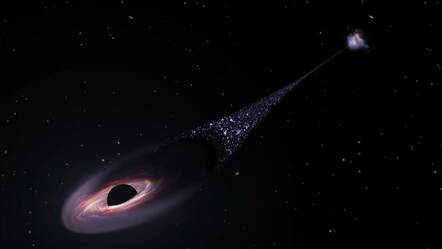This article is more than 1 year old
Astronomers clock runaway black hole leaving trail of fresh stars
Move fast, make things
A runaway supermassive black hole is speeding through space and creating a trail of stars behind it, a phenomenon accidentally discovered by the Hubble Space Telescope.
The rogue object, estimated to be 20 million times more massive than the Sun, is believed to have been forcefully kicked from its host galaxy after it came into contact with other supermassive black holes. It's now barreling through space at such a velocity, it could cross the distance from Earth to the Moon in just 14 minutes.

Artist's impression of the runaway renegade black hole ... Image credit: NASA, ESA, Leah Hustak (STScI)
Black holes are usually destructive. They grow by gobbling up nearby matter, and can rip apart stars and swallow clouds of gas and dust. Nothing can escape their pull once past the event horizon, not even light. That said, a team led by Yale University scientists have discovered one hole that has created a whopping 200,000-light-year-long chain of newborn stars behind it.
They clocked the phenomenon in an image captured by NASA's Hubble Space Telescope, and immediately realized they had stumbled on something unique when they looked closer.
"The Hubble image was taken for a completely unrelated project, a study of a possible galaxy without dark matter elsewhere," Pieter van Dokkum, first author of the study published in The Astrophysical Journal Letters, and an astronomy professor at Yale, told The Register this week.
"I was looking at the rest of the image to see if the data were of the right quality and there were no problems with it. I noticed the weird straight line and initially thought it was indeed some kind of error or problem with the data. I convinced myself it was a real object, and then we decided to observe it with the Keck telescope to try to figure out what it was."
- Bright light from black holes found to be caused by particle shock waves
- This ancient quasar may be the remains of the first-gen star that started us all
- Square Kilometre Array Observatory construction commences
- To build a better quantum computer, look into a black hole, says professor Brian Cox
After spotting the lone supermassive black hole, they were surprised to see it had left a trail of bright new stars in its wake. It's possible that interstellar gas is being shocked and heated as the black hole travels through it, triggering the material to collapse and form fresh stars.
"The implications of the triggered star formation still need to be worked out; it is interesting to think that quite a few stars may have formed this way. The total brightness of the streak is almost half that of the galaxy, and so right now the impact is quite large. However, looking over the entire lifetime of the galaxy it's a much smaller effect," van Dokkum told us.
The implications of the triggered star formation still need to be worked out; it is interesting to think that quite a few stars may have formed this way
By following the trail, the team can point to which galaxy the supermassive black hole came from. They believe it was ejected after colliding with two other supermassive black holes that merged to become a binary object 50 million years ago when two different galaxies came together.
But when a third galaxy came along with its own supermassive black hole, it led to an unstable gravitational configuration. One of them got ejected and became the rogue object astronomers later discovered, it's thought. "We've looked at many thousands of Hubble images over the years, and none of us had ever seen something like this," van Dokkum said.
Now, the team is on a lookout to find more of these newborn star streaks in space. Astronomers could use machine learning algorithms to detect more runaway supermassive black holes to study their growth and evolution.
"We also learn about the gas that lives around galaxies. The black hole triggered this gas into forming stars, and in this way we [can] learn about the properties of the gas, how it moves, and simply where it is. That's all information that's generally very hard to figure out," he said. ®
